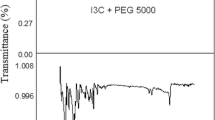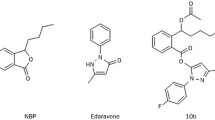Abstract
The effects of the halogenated aromatic amino acid 3,5-dibromo-d-tyrosine (3,5-DBr-d-Tyr) were studied in rat models of stroke and epileptic seizures caused by middle cerebral artery occlusion (MCAo) through respective intracerebral injection of endothelin-1 (ET-1) and intraperitoneal (i.p.) injection of pentylenetetrazole (PTZ). 3,5-DBr-d-Tyr was administered as three bolus injections (30 or 90 mg/kg, i.p.) starting at 30, 90, and 180 min after ET-1 administration or as a single bolus (30 mg/kg, i.p.) 15 min prior to PTZ administration. Neurological deficits and infarct volume were estimated 3 days after ET-1 administration and seizure score was assessed during the first 20 min after PTZ administration. The safety of 3,5-DBr-d-Tyr was evaluated in control animals using telemetry to measure cardiovascular parameters and immunostaining to assess the level of activated caspase-3. 3,5-DBr-d-Tyr significantly improved neurological function and reduced infarct volume in the brain even when the treatment was initiated 3 h after the onset of MCAo. 3,5-DBr-d-Tyr significantly depressed PTZ-induced seizures. 3,5-DBr-d-Tyr did not cause significant changes in arterial blood pressure, heart rate and spontaneous locomotor activity, nor did it increase the number of activated caspase-3 positive cells in the brain. We conclude that 3,5-DBr-d-Tyr, by alleviating the deleterious effects of MCAo and PTZ in rats with no obvious intrinsic effects on cardiovascular parameters and neurodegeneration, exhibits promising potential as a novel therapeutic direction for stroke and seizures.




Similar content being viewed by others
References
Biondi R, Ambrosio G, Liebgott T, Cardounel AJ, Bettini M, Tritto I, Zweier JL (2006) Hydroxylation of D-phenylalanine as a novel approach to detect hydroxyl radicals: application to cardiac pathophysiology. Cardiovasc Res 71:322–330
Cao W, Shah HP, Glushakov AV, Mecca AP, Shi P, Sumners C, Seubert CN, Martynyuk AE (2009) Efficacy of 3, 5-dibromo-l-phenylalanine in rat models of stroke, seizures and sensorimotor gating deficit. Br J Pharmacol 158:2005–2013
Chen M, Lu TJ, Chen XJ, Zhou Y, Chen Q, Feng XY, Xu L, Duan WH, Xiong ZQ (2008) Differential roles of NMDA receptor subtypes in ischemic neuronal cell death and ischemic tolerance. Stroke 39:3042–3048
Dirnagl U, Macleod MR (2009) Stroke research at a road block: the streets from adversity should be paved with meta-analysis and good laboratory practice. Br J Pharmacol 157:1154–1156
Exner M, Hermann M, Hofbauer R, Kapiotis S, Gmeiner BM (2003) Free and peptide-bound DOPA can inhibit initiation of low density lipoprotein oxidation. Free Radic Res 37:1147–1156
Garcia JH, Wagner S, Liu KF, Hu XJ (1995) Neurological deficit and extent of neuronal necrosis attributable to middle cerebral artery occlusion in rats: statistical validation. Stroke 26:627–634 (discussion 635)
Glushakov AV, Dennis DM, Morey TE, Sumners C, Cucchiara RF, Seubert CN, Martynyuk AE (2002) Specific inhibition of N-methyl-d-aspartate receptor function in rat hippocampal neurons by l-phenylalanine at concentrations observed during phenylketonuria. Mol Psychiatry 7:359–367
Glushakov AV, Dennis DM, Sumners C, Seubert CN, Martynyuk AE (2003) l-phenylalanine selectively depresses currents at glutamatergic excitatory synapses. J Neurosci Res 72:116–124
Glushakov AV, Glushakova O, Varshney M, Bajpai LK, Sumners C, Laipis PJ, Embury JE, Baker SP, Otero DH, Dennis DM, Seubert CN, Martynyuk AE (2005) Long-term changes in glutamatergic synaptic transmission in phenylketonuria. Brain 128:300–307
Gonzalez CL, Kolb B (2003) A comparison of different models of stroke on behaviour and brain morphology. Eur J Neurosci 18:1950–1962
Hardingham GE (2006) Pro-survival signalling from the NMDA receptor. Biochem Soc Trans 34:936–938
Hetman M, Kharebava G (2006) Survival signaling pathways activated by NMDA receptors. Curr Top Med Chem 6:787–799
Martynyuk AE, Seubert CN, Yarotskyy V, Glushakov AV, Gravenstein N, Sumners C, Dennis DM (2006) Halogenated derivatives of aromatic amino acids exhibit balanced antiglutamatergic actions: potential applications for the treatment of neurological and neuropsychiatric disorders. Recent Pat CNS Drug Discov 1:261–270
Mecca AP, O’Connor TE, Katovich MJ, Sumners C (2009) Candesartan pre-treatment is cerebroprotective in a rat model of endothelin-1 induced middle cerebral artery occlusion. Exp Physiol 94:937–946
Mehta SL, Manhas N, Raghubir R (2007) Molecular targets in cerebral ischemia for developing novel therapeutics. Brain Res Rev 54:34–66
Murrant CL, Reid MB (2001) Detection of reactive oxygen and reactive nitrogen species in skeletal muscle. Microsc Res Tech 55:236–248
Park S, Geddes TJ, Javitch JA, Kuhn DM (2003) Dopamine prevents nitration of tyrosine hydroxylase by peroxynitrite and nitrogen dioxide: is nitrotyrosine formation an early step in dopamine neuronal damage? J Biol Chem 278:28736–28742
Sharkey J, Ritchie IM, Kelly PA (1993) Perivascular microapplication of endothelin-1: a new model of focal cerebral ischaemia in the rat. J Cereb Blood Flow Metab 13:865–871
van der Vliet A, O’Neill CA, Halliwell B, Cross CE, Kaur H (1994) Aromatic hydroxylation and nitration of phenylalanine and tyrosine by peroxynitrite Evidence for hydroxyl radical production from peroxynitrite. FEBS Lett 339:89–92
Yarotskyy V, Glushakov AV, Sumners C, Gravenstein N, Dennis DM, Seubert CN, Martynyuk AE (2005) Differential modulation of glutamatergic transmission by 3, 5-dibromo-l-phenylalanine. Mol Pharmacol 67:1648–1654
Acknowledgments
We would like to thank Laura Bohatch and Loel Warsch for technical assistance. This work was supported by Grants NS060862 from the NIH, 08KB02 from the Florida Biomedical Research Program, by the University of Florida McKnight Brain Institute, JS Gravenstein MD Endowment, and I. Heermann Anesthesia Foundation, Inc.
Author information
Authors and Affiliations
Corresponding author
Rights and permissions
About this article
Cite this article
Cao, W., Glushakov, A., Shah, H.P. et al. Halogenated aromatic amino acid 3,5-dibromo-d-tyrosine produces beneficial effects in experimental stroke and seizures. Amino Acids 40, 1151–1158 (2011). https://doi.org/10.1007/s00726-010-0739-4
Received:
Accepted:
Published:
Issue Date:
DOI: https://doi.org/10.1007/s00726-010-0739-4




